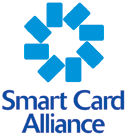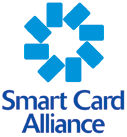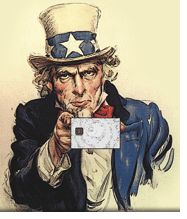Alliance conference is best opportunity to keep up with government smart card usage
24 January, 2005
category: Biometrics, Contactless, Education, Library
 With the U.S. government turning into the biggest customer for smart card technology–thanks to a huge push from President Bush–the Smart Card Alliance’s fourth annual smart cards in government conference in Washington, D.C. is coming at an ideal time.
With the U.S. government turning into the biggest customer for smart card technology–thanks to a huge push from President Bush–the Smart Card Alliance’s fourth annual smart cards in government conference in Washington, D.C. is coming at an ideal time.
Officially titled Smart Cards in eGovernment 2005, the session kicks off March 8 with a pre-conference workshop on secure credentialing, followed by the three-day conference itself.
“The theme is how the federal government has emerged to become the largest user of smart cards in the U.S.,” said Randy Vanderhoof, SCA’s executive director. “Government adoption of smart card technology is growing at a faster rate than many non-government segments.”
This year’s conference theme “is built around Presidential Directive 12 mandating a strong ID credential for all government employees,” said Mr. Vanderhoof. “The specifications for that policy will be released by the end of February and government agencies will be under a time clock to comply with those specs.”
This presidential directive set in motion a federal enterprise-wide smart card standardization effort. In addition, there was the much publicized U.S. Passport office’s ePassport program that goes into effect in 2005 along with other high profile projects from the Department of Defense, Department of Homeland Security, NASA, Veterans Affairs, and even some state governments.
This promises to make 2005 the ‘Year of the Government’ for smart cards in the United States, said Mr. Vanderhoof.
“We expect between 400 and 500 at this year’s conference. We had 360 attend last year,” he said. In addition to more attendees, there will also be more exhibitors – 34 this year, as compared to 20 last year. Exhibitors will showcase much of the technology that will be used in current and future government and commercial rollouts. “Each year this conference has grown,” he said.
“This is really the premier event, to see, not only the latest technologies, but also to hear from the federal government leaders who are implementing these standards and policies for smart card ID credentials,” said Mr. Vanderhoof. “This is a great opportunity to find out what their plans are for the future; and what they are looking for from the smart card industry to meet their objectives.”
Conference sponsors include Axalto, Oberthur, HID, SCM, and SuperCom, all of whom play key roles in some top U.S. government projects, such as TWIC, the Common Access Card, U.S. VISIT, and the Registered Traveler program.
This year’s pre-conference educational workshop will offer an in-depth look at how smart card technology works and how it will be used by the federal government.
Once again, the conference will host the Federal Smart Card Users Group’s regular open meeting that is held every other month and is free to anyone who wishes to attend. This is an opportunity to hear from the government leaders about how their agency’s programs are advancing. People can attend this meeting even if they’re not registered for the Alliance’s conference, said Mr. Vanderhoof.
“In short, our conference agenda will focus around technology and implementation of smart cards; the exhibit hall will showcase technologies; and attendees will also be able to network at receptions to meet leaders from government and industry who are active developing smart card projects or technology,” said Mr. Vanderhoof.
Some of the speakers include: Judith Spencer, chair of the Federal Credentialing Committee, General Services Administration; Larry Jellen, general manager for the Security and Intelligent Document Unit, Government Printing Office; and Rob Atkinson, vice president of the Progressive Policy Institute, a government think tank on policy issues and a strong advocate for the adoption of smart card security standards.
“This conference is an opportunity for both (federal government leaders and vendors) to come together in one event to learn from each other,” added Mr. Vanderhoof.
Here’s a brief overview of both the pre-conference workshop March 8 and the Smart Cards in eGovernment Conference 2005 March 9-11.
March 8 Pre-conference–Government Secure Credentialing workshop:
- Smart card standards from GSC-IS to FIPS 201
- Smart card security, NIST SP800.73
- External and internal attributes of a secure credential
- Contactless smart cards
- Implementation and integration of logical and physical security
- Card issuance
- Roundtable with industry experts.
Smart Cards in eGovernment 2005
March 9
- 9-noon: Federal Smart Card Project Managers Group meeting (you do not have to be registered for the conference to attend this meeting).
- Starting at 2:45: Keynote address on Presidential Directive 12, Moving Government Towards a Common Identity Credential (speaker to be announced).
- The Federal Identity Management Handbook, Judith Spencer, Federal Credentialing Committee chair, GSA.
- U.S. ePassports: Meeting the New ICAO Standards, Frank Moss, deputy assistant secretary, passport services, Bureau of Consular Affairs, U.S. Department of State.
- Government Printing Office: New Directions and Challenges for Secure Documents, Larry Jellen, general manager, GPO’s Security and Intelligent Document Unit.
- The Legislative Environment for Identity Management Reform, Rob Atkinson, vice president, Progressive Policy Institute.
March 10
(Concurrent Sessions)
Track 1: Technology and Standards
- Overview of FIPS 201 and SP800.73, Jim Dray, NIST.
- IAB Committee panel on Data Models, Card Interface and Card API.
- IAB Committee Panel on Business Policy, Conformance, and Acquisition.
- FIPS Position on Card Management.
- NIST Special Publication on Biometrics.
- Industry Panel: Meeting the HSPD-12 Challenge (card industry, readers, middleware, and integrator approaches).
Track 2: Business and Implementation Issues
- Panel: Alternative Approaches to Identity Management and Security (Visa and passports, ID cards, networks, driver’s licenses).
- Cross Credentialing: Breaking down the Barriers.
- Convergence of Logical and Physical Security, Making the Pieces Fit.
- Convergence of Transit Payment and Government ID.
- Examples of Government Smart Cards in Action (DOD’s Common Access Card, Department of Homeland Security, General Services Administration, NASA, and Veterans Administration.
Following the concurrent sessions, there will be an invitation-only briefing for CIOs and CFOs of federal agencies on HSPD-12.
March 11
(Concurrent Sessions:)
Track 1, Technology and Standards
- Panel: Contactless chips in ePassports and eVisas (ICAO mandatory and optional standards, Fact versus fiction on Passport Vulnerabilities, Managing Biometrics on Passports).
- Java versus .Net Security and Applications.
- More from GSC to ASNI to ISO.
- Panel: Conformance and Certification (New FIPS 140-3 Chip Security Tests, Pre-Issuance Testing and security, ANSI B10 testing models).
Contactless and Dual Interface Chips, examining the security issues.
Advances in Biometrics Developments.
Track 2, Business and Implementation Issues
- Panel: HSPD-12 Policy and Implementation Guidelines (interpreting the directive, identity proofing, implementation issues).
- Panel: Implementation Guidance, Navigating the FICC Manual.
Multi-agency Aggregate Buying. - Central versus De-Centralized Card Issuance.
- Examples of Government Smart Cards in Action (from the Department of State and U.S. Treasury and others).
- Public Facing Government ID Cards (TWIC and Registered Traveler).
For registration and other conference information: www.smartcardalliance.org/allianceactivities/nextmeeting.cfm.
Research and evaluate FIPS 201 Approved Products and get the latest info on compliant credentialing systems at FIPS201.com. Click to visit FIPS201.com.



